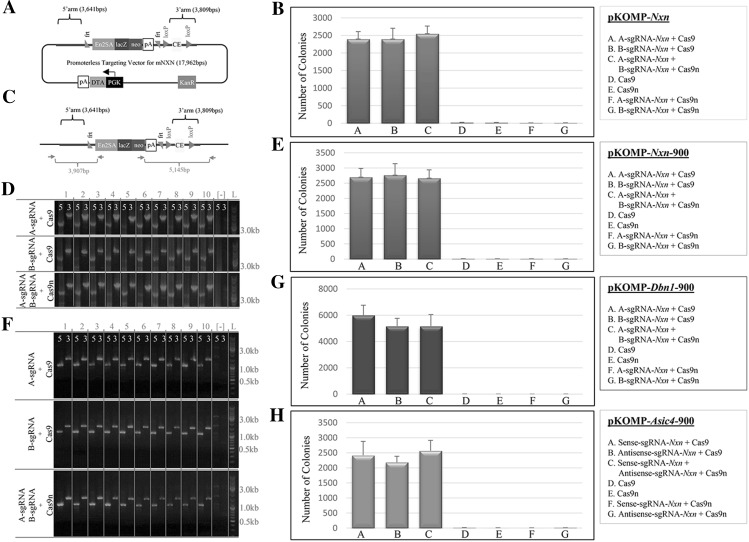Fig. 2.
Cas9(n)-mediated targeting efficiency of constructs with long and short homology arms. a pKOMP-Nxn construct diagram. The promoterless construct was designed such that the lacZ reporter and neomycine/G418-resistance gene were controlled by the endogenous Nxn promoter upon proper targeting. The critical exon (CE) was flanked by loxP sequences, therefore, the transgenic mouse derived from this construct can be converted into either a conditional or reporter-marked knockout. b Bar graph showing the number of G418-resistant ES cell colonies post-electroporation with plasmids expressing sgRNA and Cas9(n), along with the unmodified pKOMP-Nxn construct. The results show an increase in the number of colonies in the Cas9(n) mediated conditions (“A”, “B”, and “C”). Conditions with Cas9(n) and pKOMP-Nxn without sgRNA(s), and sense- or antisense-sgRNA-Nxn with Cas9n and pKOMP-Nxn, were used as negative controls (“D”, “E”, “F”, and “G”). c Diagram illustrating the junction PCR method for verifying correct targeting with products of 3907 bp (5′ arm) and 5145 bp (3′ arm). d Junction PCR results for 10 random colonies selected from the G418-resistant colonies. The top row shows PCR products from 10 random colonies selected from electroporation using plasmids expressing A-sgRNA-Nxn and Cas9, along with pKOMP-Nxn. The middle row shows B-sgRNA-Nxn and Cas9, along with pKOMP-Nxn. The bottom row shows A-sgRNA-Nxn, B-sgRNA-Nxn and Cas9n, along with pKOMP-Nxn. (−), negative control. e Same bar graph as (b) except using the pKOMP-Nxn-900 targeting construct. f Same PCR as (d) except based for clones generated by the pKOMP-Nxn-900 targeting construct. The expected PCR products are 1105 bp (5′ junction) and 1463 (3′ junction). (−), negative control. g Same bar graph as (b) except using the pKOMP-Dbn1-900 targeting construct (Fig. 1a). h Same bar graph as (b) except using the pKOMP-Asic4-900 targeting construct (Fig. 1a)

